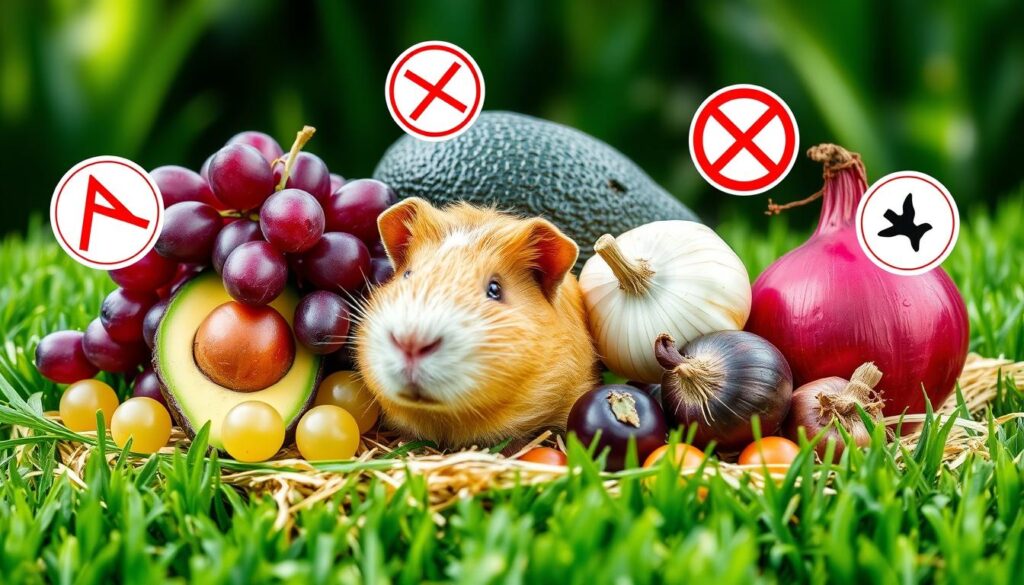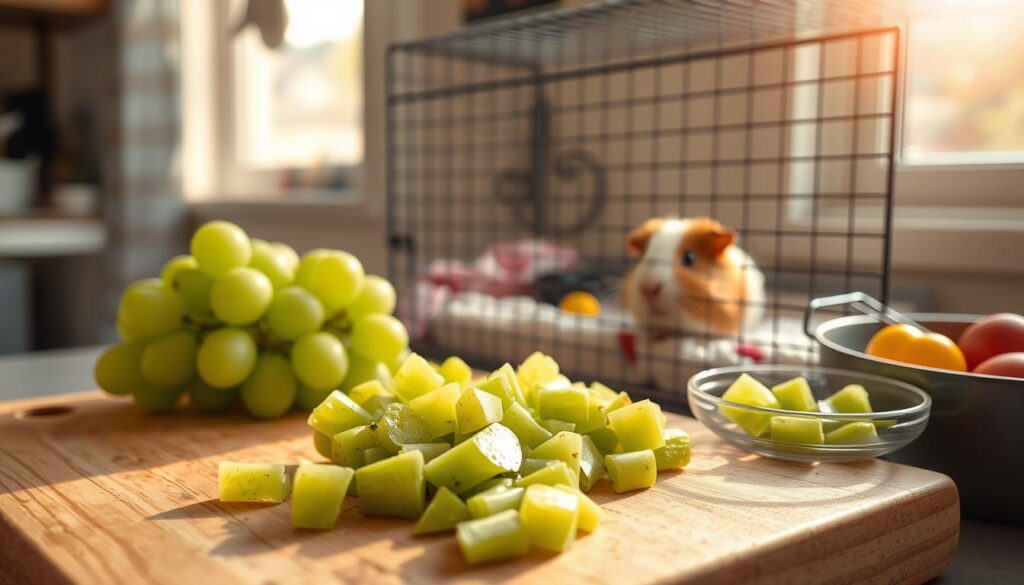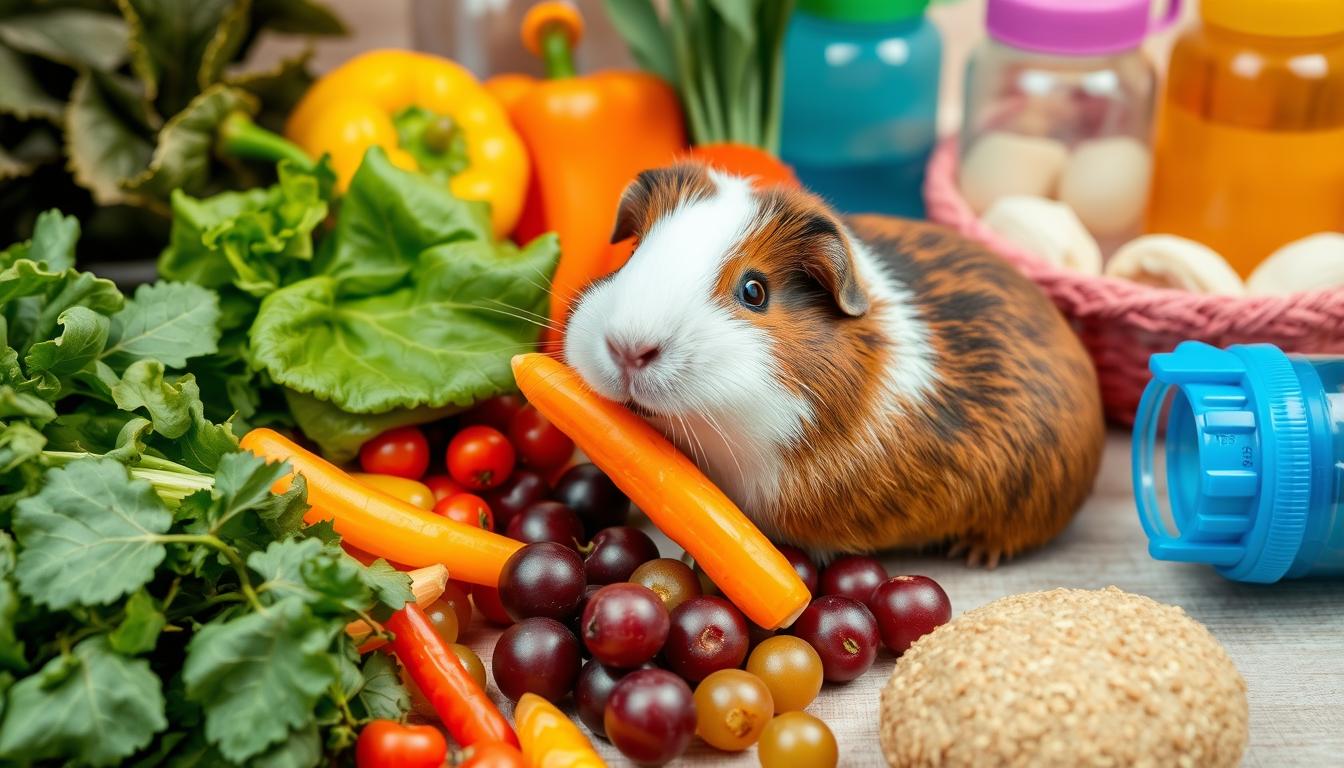As a devoted guinea pig parent, you want the best for your furry friend. You might wonder, “Can guinea pigs have grapes?” These juicy fruits can be tempting, but it’s important to know the risks and how much to give. This guide will help you understand the benefits and how to feed grapes safely to keep your guinea pig happy and healthy.
Grapes might be tasty for us, but they need careful thought in your guinea pig’s diet. With the right approach, grapes can be a fun addition to their meals. Let’s explore how to safely add grapes to your guinea pig’s diet.
Table of Contents
Understanding Guinea Pig Nutrition Basics
Guinea pigs need the right food to stay healthy. They have special dietary needs that pet owners must know. This ensures they live their best lives. Let’s explore what makes up a good diet, how much they need, and why vitamin C is key.
Essential Components of a Healthy Diet
A good diet for guinea pigs includes:
- 80% hay (mainly timothy hay)
- 10% fresh vegetables
- 5% high-quality pellets
- 5% fresh fruits
Hay is the base of their diet, helping with digestion and teeth. Leafy greens and bell peppers add important vitamins and minerals. Pellets should be fiber-rich but low in sugar. Fruits are okay but in small amounts because of their sugar.
Daily Nutritional Requirements
Guinea pigs need certain nutrients every day. They require:
- 20-25 mg of Vitamin C daily, as they can’t make it
- A balanced mix of calcium, magnesium, and phosphorus to avoid bladder stones
- Always access to fresh, clean water to stay hydrated
It’s vital to give them a balanced diet. This meets their daily needs and keeps them healthy for a long time.
The Importance of Vitamin C
Vitamin C is vital for guinea pigs since they can’t make it. Without enough, they can get scurvy. This can cause pain, tiredness, and even death. So, it’s crucial to give them the right amount of vitamin C every day.
Knowing about guinea pig nutrition helps you feed them well. This supports their health and happiness. Always talk to a vet if you’re unsure about their diet or health.
Can Guinea Pigs Have Grapes
The good news is that guinea pigs can safely enjoy grapes as an occasional treat. Unlike dogs, grapes are not toxic to these furry friends. But, because of their high sugar content, grapes should be given sparingly.
The recommended serving size is one or two small grape pieces, once or twice a week, for an adult guinea pig. It’s important to introduce new foods gradually and watch for any adverse reactions.
When feeding grapes to your guinea pig, make sure to remove any seeds or stems. These can pose a choking hazard. You can also try dicing the grape or mashing it into a jelly-like consistency to make it more enjoyable for your pet.
Remember, fruits like grapes should only make up 5% of a guinea pig’s diet. The bulk of their nutritional needs should come from high-fiber, low-sugar foods such as hay, vegetables, and a small amount of pellets.
While grapes can be a tasty treat, it’s crucial to feed them in moderation to avoid potential health issues. By following these guidelines, you can safely and responsibly incorporate grapes into your guinea pig’s well-balanced diet.
Nutritional Benefits of Grapes for Guinea Pigs
Grapes are good for your guinea pig’s health. They have vitamins, minerals, and antioxidants. These help your pet stay healthy and grow well.
Vitamins and Minerals in Grapes
Grapes are full of Vitamin C, which is great for guinea pigs. A cup of grapes has about 3.2 mg of Vitamin C. This boosts the immune system and keeps the skin and coat healthy.
Grapes also have potassium. This helps keep the body’s fluids balanced and muscles working right.
Antioxidant Properties
Grapes have antioxidants like quercetin, resveratrol, and polyphenols. These fight off harmful free radicals. They help keep the immune system strong. Darker grapes, like purple, red, or black, have more antioxidants.
Hydration Benefits
Grapes are full of water. They help keep your guinea pig hydrated, especially when it’s hot or they’re active. Staying hydrated is key for healthy organs and avoiding dehydration.
Grapes are a good treat for your guinea pig, but only in small amounts. Always introduce new foods slowly. Watch how your pet reacts to make sure they can eat them.
Potential Risks of Feeding Grapes
Grapes can be a fun treat for your guinea pig, but be careful. They have a lot of sugar, about 15 grams per 100 grams. Eating too many can cause serious health problems.
One big worry is obesity, diabetes, and dental issues. Guinea pigs love sweet foods too much. This can mess up their digestion and lead to these problems. Also, big grapes can block their airway, so cut them small before giving them to your pet.
Some guinea pigs might be allergic to grapes, but it’s rare. Always start with a little bit and watch how they react. Also, make sure grapes are organic to avoid pesticides.
To avoid these problems, only give grapes sometimes and in small amounts. They should not be a big part of their diet. Treats like grapes should be given now and then, not every day.
By knowing these risks and giving grapes in moderation, you can keep your guinea pig healthy. Enjoying grapes as a treat can be good for them, as long as you watch their diet.

Safe Serving Sizes and Frequency
Feeding your guinea pig grapes should be done with care. Give them 1-2 small grape pieces, no more than once or twice a week. Make sure to cut the grapes into tiny pieces to avoid choking.
Start with a tiny piece of grape and watch for any signs of trouble. This helps ensure your guinea pig is safe and healthy.
Weekly Portion Guidelines
- 1-2 small grape chunks, 1-2 times per week
- Cut grapes into pea-sized pieces to avoid choking
- Introduce grapes slowly, monitoring for any sensitivities
Best Times for Grape Treats
Think of grapes as an occasional treat, not a daily snack. Add them to your guinea pig’s diet along with hay, fresh veggies, and nuggets. This way, they get the nutrients they need and enjoy grapes as a special treat.
| Food | Optimal Portion | Frequency |
|---|---|---|
| Hay | Unlimited | Continuous access |
| Guinea Pig Nuggets | 1/8 – 1/4 cup per day | Daily |
| Fresh Vegetables | 1-2 cups per day | Daily |
| Grape Treats | 1-2 small pieces | 1-2 times per week |
“Grapes should be considered a special treat, not a dietary staple, for your guinea pig.”
How to Prepare Grapes for Your Guinea Pig
Feeding your guinea pig grapes can be a fun and healthy treat. But, it’s important to prepare them safely. This ensures your guinea pig stays healthy and happy.
First, wash the grapes well to get rid of any harmful chemicals. Then, take out the seeds and pits to avoid choking hazards. These steps are crucial for your pet’s safety.
- Cut the grapes into small, pea-sized pieces for easy consumption by your guinea pig.
- Opt for organic grapes whenever possible to minimize your pet’s exposure to potentially harmful chemicals.
- Darker grapes, such as purple, red, or black varieties, are generally preferable due to their higher nutritional value.
- Serve the grape pieces at room temperature, as your guinea pig may be more inclined to enjoy them at this temperature.
Remember, grapes should be a rare treat, not a regular part of their diet. Too much fruit, including grapes, can be bad. By following these tips, you can give your guinea pig a fun grape treat safely.

| Grape Serving Size | Frequency | Percentage of Diet |
|---|---|---|
| 1/4 grape | 1-2 times per week | No more than 10% |
Watch how your guinea pig reacts to grapes. Stop giving them grapes if they show signs of upset stomach or allergies. By being careful and attentive, you can add grapes to their diet safely.
Signs of Grape Allergies in Guinea Pigs
Grape allergies in guinea pigs are rare, but it’s important to watch for signs. This way, you can keep your guinea pig healthy. Let’s look at the common signs of grape allergies and when to see a vet.
Common Allergic Reactions
Some common signs of grape allergy in guinea pigs include:
- Swelling of the face or other body parts
- Hives or skin irritation
- Diarrhea or other digestive issues
- Difficulty breathing or respiratory distress
If you see these symptoms after giving grapes, stop the treat right away. Watch your guinea pig closely.
When to Contact a Vet
If your guinea pig has trouble breathing or keeps having digestive problems, call a vet fast. Grape allergies can be serious and even life-threatening. Quick vet care is crucial for your pet’s safety.
Being careful and watching your guinea pig’s health is important. Knowing the signs of grape allergies and when to get help keeps your pet happy and healthy.
Different Types of Grapes for Guinea Pigs
There are many types of grapes you can give to your guinea pig. You can choose from red, green, purple, and black grapes. Darker grapes have more antioxidants and nutrients, making them a better choice.
It’s best to pick seedless grapes for your guinea pig. This way, you avoid choking hazards and digestive problems. But, it’s important to avoid raisins because they have too much sugar.
If you have wild grapes, make sure they are clean and free from pesticides. Grapes from your garden are also good, as long as they are pesticide-free. Always remember to give grapes in moderation to keep your guinea pig’s diet balanced.

